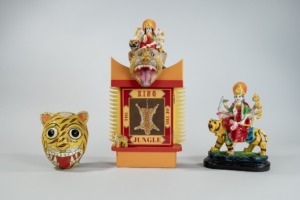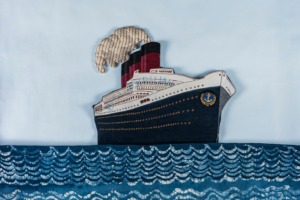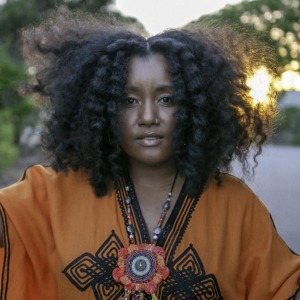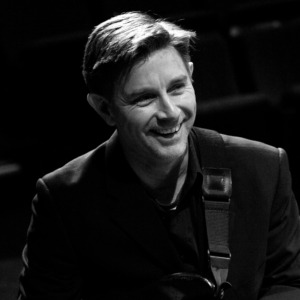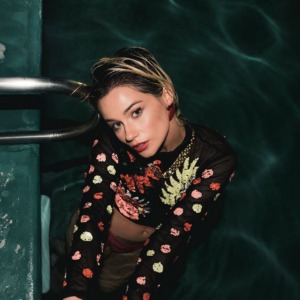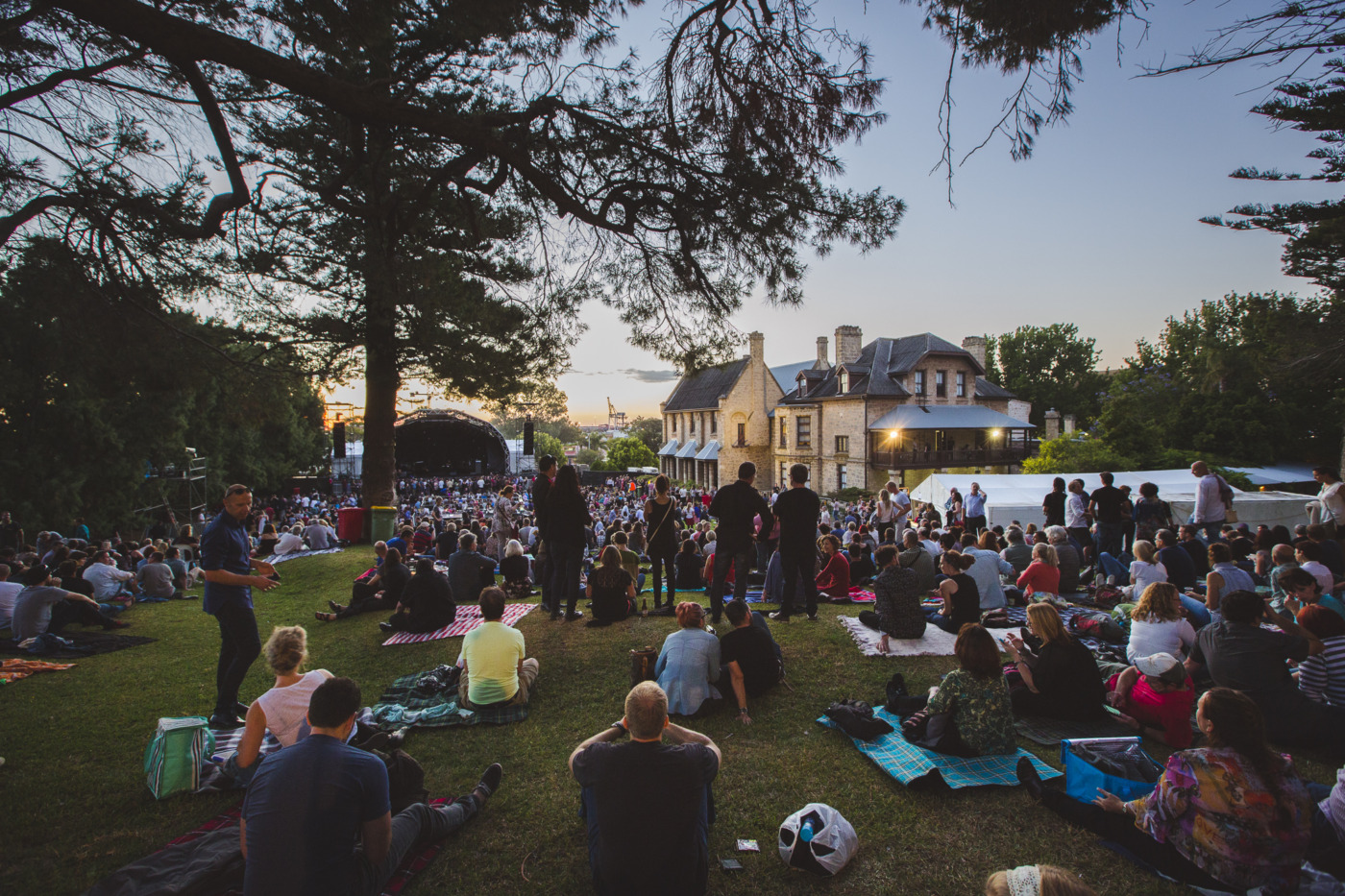Sharyn Egan is a painter, weaver and sculptor. As a member of the Stolen Generation who grew up in the New Norcia Mission School much of her artwork is a commentary on her life as a Noongar woman and the associated trauma, emotions and deep sense of loss and displacement experienced by Aboriginal people.
Never afraid of experimentation and exploration, she works in numerous media, including painting, sculpture, woven forms and site-specific installations, often choosing materials, such as ochres, resins and grasses that connect to land, especially her home near the lake system in the southern suburbs of Perth.
At the Indian Ocean Craft Triennial’s inaugural exhibition Curiosity & Rituals of the Everyday, Sharyn will present her collaborative installation What’s in a Noongar woman’s bag? Naatj Noongar yoka kooda, an exploration into the daily lives of her ancestors, using historical research and oral histories to trace the belongings found in a Noongar women’s bag in the 1800s.
How did you come up with the concept for What’s in a Noongar Woman’s Bag (Naatj Noongar yoka kooda)?
I was approached by Maggie and Jude to develop a project for IOTA 2021. I think it’s really important for Aboriginal women to have an understanding of where they came from and what life was like for their ancestors. I’m from the stolen generation, my mum is from the stolen generation and so is my grandmother.
So, this project aims to bring back a bit of knowledge about the generations before, and how life wasn’t that easy for them. They had to be prepared, organised and responsible, as they weren’t just looking out for themselves, but their whole community. In their bags, you wouldn’t find lipstick and mirrors, but objects that were essential for survival.
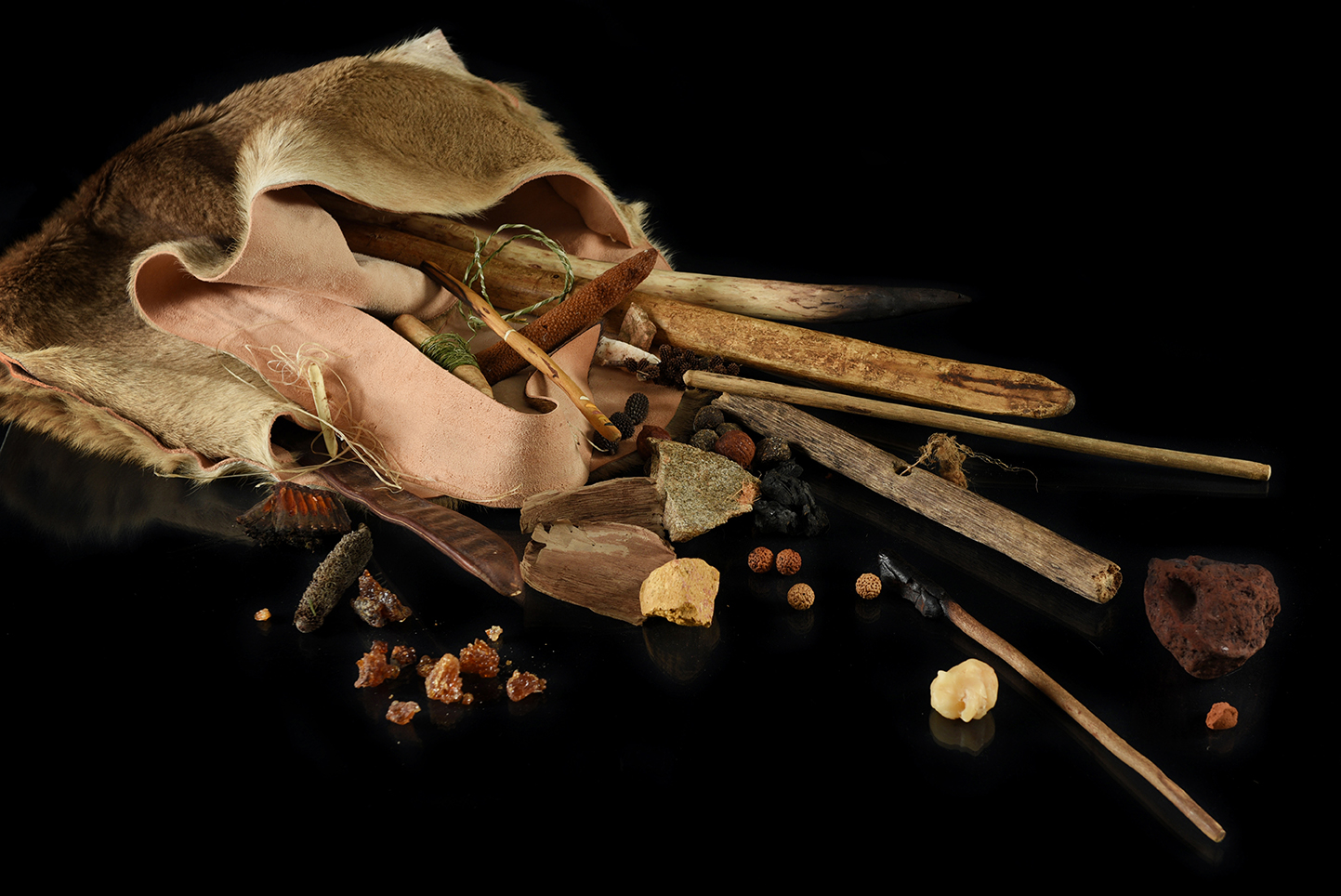
Sharyn Egan, What’s in a Noongar Woman’s Bag? Naatj Noongar yoka kooda 2021. Collaboration with Djidi djidi group. Gail Beck, Luana Daley, Margaret Drayton, Brenda Hill, Doris Hill, Kaye Walley, Marie Walley, Kathleen Toomath, Larissa Perry, Georgia Shuttleworth. Kangaroo skin, found objects, dimensions variable. Photography by Christophe Canato.
I understand the project was based on a list written in 1839 by the explorer Sir George Grey. How did you come across this information?
In the year 2000 I did a cultural tourism course at Fremantle TAFE, and that’s where I came across George Grey’s list. It details 23 objects typically found in a woman’s bag, with contents including a flat stone to pound roots, cakes of gum to make and mend weapons, kangaroo sinew to make spears and sew with, banksia cones or dry white fungus to kindle fire. I was really intrigued by it and always wanted to learn more about it, and I guess this project for IOTA offered the perfect opportunity to do that.
When I started to research, I came across another list by a woman named Ethel Hassell, a colonial author who lived near Albany and wrote several texts on the Noongar people of Southwest Australia. She had a pretty comprehensive list, including a few extra items, and it was written very much from the woman’s perspective, so it was a great resource for this project.
I understand you collaborated with a group of 14 Noongar women to develop this project – including taking some trips out bush to collect materials and create the kangaroo skin bags. Were there any interesting discoveries made on your travels?
Yeah most of the women were friends of mine or people I had worked with before, but we were from quite diverse Noongar groups. I invited them to come away on some trips, and there was lots of storytelling and sharing, and discussing what life was like back then.
We went up to Yued Country (New Norcia). I grew up in a mission there and so did one of the other ladies. So we talked a lot about what it would’ve been like before the Europeans settled, the landscape and the stories of our ancestors there. Speaking about our heritage while we were there, walking on the land together, collecting materials like sinew from kangaroo tails and banksia cones to kindle fire, was pretty special.
It just made us appreciate bush medicine and fixing things, and how resourceful our ancestors were. They really made excellent use of what they had in front of them, and it all came from the land. The contemporary tools are not necessarily better.
And what will the bags be made of and how will they be displayed?
They’ll be made of kangaroo skin and sinew from the kangaroo tails. They will be quite contemporary in terms of style, like a modern woman’s shoulder bag with a strap, but made from traditional materials. Each of them will contain some traditional materials a Noongar woman would’ve carried in the 1800s, so the audience can have a peek in, plus we’ll have a table with an open bag with its contents sprawled out for ease of viewing.
Curiosity and Rituals of the Everyday is showing at FAC as part of the Indian Ocean Craft Triennial from 18 Sep — 7 Nov 2021.
The Indian Ocean Craft Triennial (IOTA) is a new festival that celebrates the traditions and rituals of contemporary craft, bringing together makers, artists and crafted works from countries around the Indian Ocean Rim.
Opening on 17 September, IOTA’s inaugural exhibition Curiosity & Rituals of the Everyday, presents the work of more than 30 artists from seven countries across two venues: Fremantle Arts Centre and John Curtin Gallery.
From the exquisitely detailed textiles and embroidery works of Jakkai Siributr (Thailand) to the painted carpentry of Ishan Khosla (India) and his team of artisans, the exhibition presents strikingly modern installations and stories of our time that are firmly planted in craft traditions.
Fremantle Arts Centre Director Anna Reece said, “Both ancient and contemporary, craft is a universal language capable of bringing people together, of creating intimate moments for reflection and speaking to the myriad of experiences that make up daily life across the Indian Ocean Rim.
“We are so proud to host IOTA’s principle exhibition Curiosity & Rituals of the Everyday, which calls out across the oceans with rich and evocative stories of culture, life and times from countries including India, Thailand, Malaysia, Singapore, Kenya, South Africa, and indeed Australia. A celebration of how deeply embedded cultural practice has and will always be in craft making.”
The official opening of IOTA21 on 17 September will see cultures come together, as Fremantle Arts Centre is transformed into a joyous celebration of dance, song and music. With performances by Noongar artists, classical Indian musicians and dancers from Saraswati Mahavidhyalaya, Tamil drummers, contemporary African performances, and much more. There will be delicious food from the unique cultures of countries represented in the triennial including Kenya, Singapore and Thailand.
Among the highlights of Curiosity & Rituals of the Everyday, Sharyn Egan, a Noongar painter, weaver and sculptor from Western Australia will present What’s in a Noongar woman’s bag? Naatj Noongar yoka kooda, a collaborative project developed with a group of Noongar women who are recreating bags made and carried by their ancestors. The starting point for the project was explorer George Grey’s comprehensive list of 23 objects typically found in a woman’s bag, written in 1839.
Ishan Khosla, an Indian designer and artist has worked with a whole community of artisans for his painted carpentry works. Khosla’s works blend contemporary Indian advertising with the traditional kaavad — a portable shrine and storytelling device — to explore concepts concerning contemporary Indian life.
Kenyan artist Cyrus Kabiru will present his spectacular wearable masks, made from scrap metal sourced from Nairobi, and Fremantle-based textile and embroidery artist Susie Vickery will present an immersive installation that will take audiences on a journey through the ocean with five curious women, past and present.
Jude van der Merwe, Co-Curator and Project Leader of IOTA, commented, “Showcasing artists from more than seven countries, the exhibition is a cross-cultural exploration of craft and the handmade across our region, offering a new, contemporary lens on this ancient practice.
“From ceramics to metalwork, embroidered and woven textiles, woodwork and pearl shell carving, the works demonstrate the incredible skill of the artists while shining a light on the importance of craft as a vital livelihood and a vehicle for community resilience.”
Taking place from September through to November, the broader IOTA21 festival program includes exhibitions, a conference, talks, workshops and a fashion event.
Curiosity & Rituals of the Everyday runs from Sat 18 Sep 2021 — Sun 07 Nov. For the full IOTA program visit indianoceancrafttriennial.com
Exhibiting Artists – Fremantle Arts Centre
Sharyn Egan (WA)
Sarah Elson (WA)
Audrey Fernandes-Satar & Arif Satar (WA)
Cyrus Kabiru (Kenya)
Ishan Khosla (India)
Darrell Sibosado and Darrell Jade Kyle (WA)
Garry Sibosado (WA)
Uday Singh (India)
Jakkai Siributr (Thailand)
Wuthigrai Siriphon (Thailand)
Thania Petersen (South Africa)
Susie Vickery (WA)
Liz Williamson (NSW)
Exhibiting Artists – John Curtin Gallery
Melissa Cameron (WA)
Tjanpi Desert Weavers – Judith Yinyika Chambers and Nancy Nyanyana Jackson (WA)
Kaaru – Sanjib Chatterjee and Anjalee Wakankar (India)
Kirit Dave (India)
Sunny Dolat (Kenya)
Andile Dyalvane (South Africa)
Pierre Fouché (South Africa)
Gaurav Jai Gupta (India)
Jan Griffiths (WA)
Yee I-Lann (Malaysia)
Shakuntala Kulkarni (India)
Desmond Lazaro (VIC)
Anniketyni Madian (Malaysia)
Athi-Patra Ruga (South Africa)
Garry Sibosado (WA)
Uday Singh (India)
Madhvi Subrahmanian (India)
Zizipho Poswa (South Africa)
Monique Tippett (WA)
Artwork details (from top)
Cyrus Kabiru Macho Nne, Amboseli Mask, 2017, C-type Print on Diasec Mount, 70 x 60 cm
Ishan Khosla with Anoop Sharma and Tasleem Ahmed, Formerly known as the king of the jungle, 2021, acrylic and digital print on wood, 35.5 x 24.3 x 12cm
Susie Vickery with Bappaditya Biswas, Kolkata, India; Janakpur Women’s Development Center, Janakpur, Nepal; Mark Binns, Fremantle, The Curious Five Go Surfing (detail), 2021, cotton thread, cotton, found objects, 50 x 35cm
Media contact
Rosamund Brennan, [email protected], 08 9432 9565
Sunday Music returns to Fremantle Arts Centre in 2021 with a stellar line-up of WA musicians. Running 2–4pm every Sunday from October through to March, visitors can enjoy a handpicked selection of local music acts in the beautiful lush surrounds of FAC’s Front Garden. Best of all, Sunday Music is free to attend.
Fremantle Arts Centre Director Anna Reece said, “Sunday Music heralds the beginning of Summer. With a brilliant and diverse offering of free live music, lazy picnics under the trees, friends catching up and enjoying longer, warmer days, Sunday Music represents Fremantle Arts Centre at its best.”
“The live music industry has struggled so much in the last year due to COVID19 so we are thrilled to be able to present this popular series for another year and to bring our community together to celebrate our Western Australian musicians.”
- Grace Barbe’s Creole All Stars
- Elli Greeneyes
- Dave Brewer’s Deluxe Combo
- Grace Sanders
October highlights include Grace Barbe’s Creole All Stars (WA), a supergroup of local musicians who’ll bring tropical vibes and African rhythms to FAC to coincide with the Indian Ocean Craft Triennial.
Also hitting the stage in October are The Struggling Kings, a rock and roll trio of brothers hailing from One Arm Point in the Kimberley and Eli Greeneyes, a Perth-bred musician who’s brash, anthemic brit rock landed him in the TheMusic.com.au’s top 25 artists to watch in 2021.
In November, be sure to catch the legendary Daniel Susnjar Afro-Peruvian Jazz Group, an award-winning 7 piece ensemble led by globally renowned WA percussionist Daniel Susnjar, and Odette Mercy, the much loved WA soul singer who’ll craft a special Soul Atomics Kids’ Party to coincide with Hundreds & Thousands, FAC’s kids’ colour exhibition.
Local reggae act South Summit will take the stage in December in a raucous celebration of afrobeats, and, after being cancelled last March due to COVID, Joan & The Giants will captivate audiences with their powerful, emotionally raw brand of alternative pop.
Sunday Music takes place in the Front Garden at FAC with a strictly limited capacity. We recommend you arrive early and settle in for the afternoon. Bring a rug and picnic (no BYO alcohol) to this family friendly event, or enjoy tasty treats from the food vendors and bar on-site. Limited seating available.
Sunday Music is possible thanks to the ongoing support of Bendigo Bank – Fremantle Community Bank Branch. 2020-21 is the twelfth year of this long-standing partnership. Sunday Music runs every week from October to March. The January – March program will be announced in December 2021.
Line up
3 Oct – Justin Walshe Folk Machine
10 Oct – Grace Sanders + Eli Greeneyes
17 Oct – Grace Barbe’s Creole All Stars
24 Oct – The Struggling Kings + Tanya Ransom
31 Oct – Ghost Care + Gap Year
7 Nov – Sugarwife + Claudie Joy and the Joy Boys
14 Nov – Daniel Susnjar Afro-Peruvian Jazz Group
21 Nov – Odette Mercy and her Soul Atomics’ Kids Soul Party
28 Nov – Dave Brewer’s Deluxe Combo
12 Dec – South Summit + Kwachala
19 Dec – Turiya + Joan and the Giants
Media contact: Rosamund Brennan, [email protected], 08 9432 9565
One of Western Australia’s most compelling contemporary artists, Jacobus Capone maintains a practice that incorporates performance, photography, video installation, painting and site-specific work.
Marked by intimate and evocative gestures, his work often combines physically demanding durational performances with sublime landscapes – exuding a sense of awe and dark optimism whilst examining human and environmental fragility. Across Capone’s works there is an unflinching drive to understand human thresholds and the timeframe of a single life.
His work has been shown in a range of solo and group exhibitions across institutions both nationally and internationally including The Museum of Contemporary Art Australia, Perth Institute of Contemporary Art, Momentum, Berlin and Australia Centre for Contemporary Art.
Beating Heart, showing at Fremantle Arts Centre from 24 July to 7 September, is the artist’s largest exhibition to date, bringing together three large bodies of work including mesmeric mark making, duration performance, installation and video works.
Your work Echo & Abyss – an immersive video installation filmed across natural environments in Switzerland and Greenland – is partly inspired by the poet Rainer Maria Rilke, in particular his Duino Elegies. Can you explain why you were so struck by Rilke’s work?
In late 2016 I undertook a residency at Villa Ruffieux in Sierre, Switzerland, not far from where Rilke lived and worked. Before going I acclimatised myself comprehensively with his work and was continually drawn back to the Duino Elegies.
I felt certain parallels with things I had explored in my practice previously, and because of this it only made sense to use the text as a reference point whilst I was based close to the Château de Muzot, his permanent residence. There’s an immediate energy I felt through the text, and how it embraces and explores the limitations of what it is to be human.
Your work often sees you place yourself within stark, freezing landscapes, from immersion in a Swiss lake in winter to peering over cliffs in the Bernese Alps. How do you go about capturing the footage? Do you film them all yourself?
I really prefer to be self sufficient, to work independently and take on as much of the work load as possible. Having said this though there are some times where my partner will help where safety is compromised.
Embracing failure is part of the process. Knowing small yet simple things are going to be extremely difficult to capture and are going to need a great deal of time invested in them. Patience and a willingness to endure are prerequisites that are sharpened through repetition.
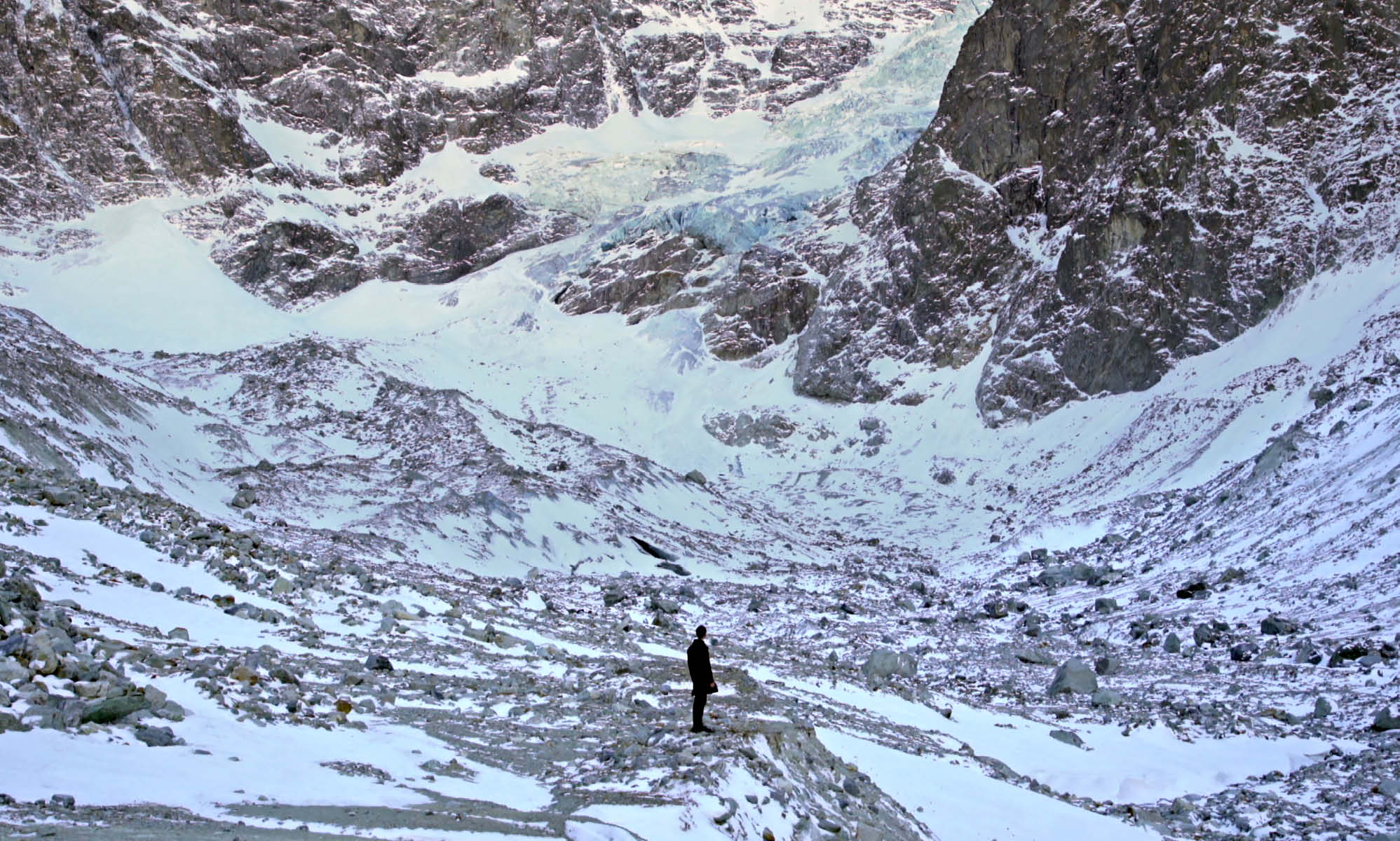
Jacobus Capone, Echo & Abyss – Chapter 6, Scene 9 (video still), 2018, synchronised 10 Channel HD video, dimensions variable. Image courtesy the artist and Moore Contemporary
What’s the hardest part about filming in these kinds of environments?
It was winter whilst in Greenland so sometimes it was minus 30 degrees centigrade before wind-chill, hence trying to film is incredibly difficult. Batteries die rapidly, lens freezes and screen displays lock up. Then there is the very real risk of frostbite and hypothermia from prolonged exposure. Just breathing outside can be difficult. Sometimes your eyelids freeze shut.
A lot of the locations were remote or volatile, so you need to be committed and feel comfortable firstly getting to the site, working and then getting back safely.
I understand you worked with a composer to develop the soundtrack for Echo & Abyss. What kind of mood or feeling you were hoping to convey within the score?
I was very fortunate Alex Turley, an Australian composer, agreed to work on the score. I provided a rough first edit of the whole project and really left the creative process up to him. He was aware of the conceptual rationale behind the project and already knew there was a sense of foreboding to potentially embrace and work with. The last thing I wished to do was to create parameters and restrict whatever he felt, so I left it totally open to him to respond to.
Your work Thanatousia – which features 34 flags, one for every year of your life – was a collaboration with your mother. Can you explain this familial connection to the work?
This project had a long gestation period and I began it properly in 2019. At first it was going to just be a one off flag, but I knew it needed much more of a earnest commitment. Both to learn from and to offer.
To individually make the flags was necessary. Throughout my childhood and teenage years my mother Maria Gomes ran her own banner and flag making business. She taught me sewing skills as a child, so asking her to collaborate on the project was second nature.
At the project’s heart was us coming together in the studio at FAC to work on the flags on a weekly basis. Spending this allocated time with my mother, as well as our usual catching up, on a continual basis for 6 months was a gift. The conversations, the silences shared, was all a powerfully enriching experience. We didn’t necessarily sit around talking about mortality, but the simple act of making the flags repetitively couldn’t help but change the way we both feel about the subject.
There was a process put in place whereby I wanted to cut and stitch all the lettering of the flags. My mother would then hem, and finalise the overall flag. I dealt with the sentences, my mother framed them.
The flags alternate through three phrases: “You will die. I will die. We will die”. What exactly about mortality – and our language around it – are you interested in exploring?
I’ve always been interested in the human dependence on words and language to give meaning. And the degree by which we become enslaved by it. Through the repetition of alternating sentences on the flags the significance of the statement fluctuates. It becomes both enshrined and exhausted. Meaningful and meaningless.
The project functions as a means and methodology hoped to aid in being liberated from the weight of one’s mortality. And through this liberation surrendering more fully to life.
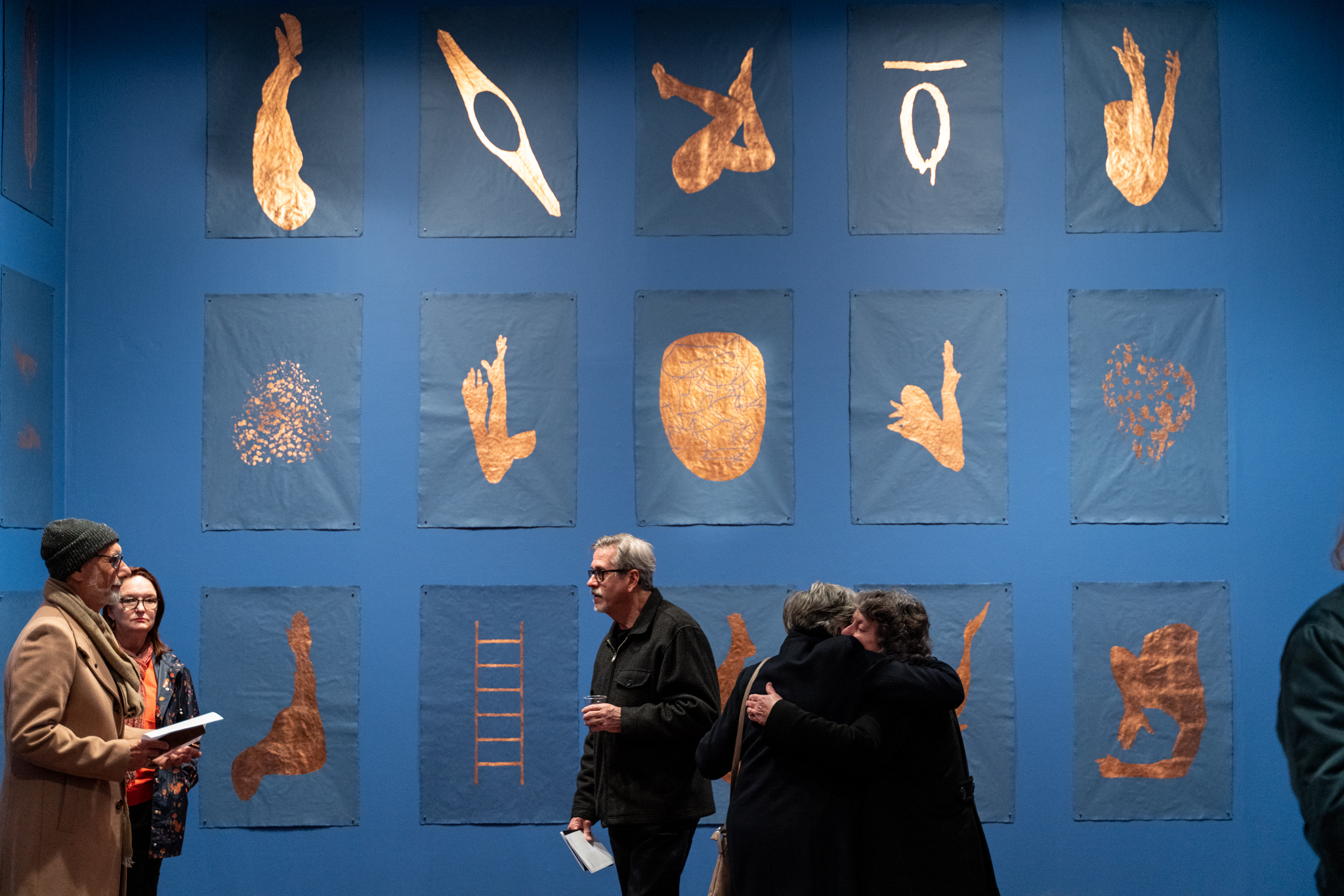
Installation view: Jacobus Capone, Perdition & Prayer (detail), 2020-ongoing copper leaf, volcanic ash and glacial water on Japanese Mingeishi paper, 900 x 640 mm
Your work Perdition & Prayer is a series of over 100 works on paper combining copper leaf, volcanic ash and glacial water on Japanese Mingeshi paper. What was the rationale behind using such unique mediums?
I’ve collected a lot of natural materials throughout years of working site specially across different countries. Various bodies of waters, stones, ashes, sands etc. Because Perdition & Prayer embraces every minuscule component that informed and shaped each previous performative undertaking it only made sense to introduce these collected elements into the paintings.
Namely volcanic ash from Iceland was mixed with glacial water from Svalbard and Tasmania to form the painterly base for all the works. Copper leaf was then applied over the top. Archives of images, words, objects, artefacts, thoughts, research and inspiration from previous projects informs the imagery of the works. Deciphered and distilled series of symbols. An iconography of sorts.
Jacobus Capone: Beating Heart is showing at Fremantle Arts Centre from 24 July to 7 September.
Image at top of page: Jacobus Capone and Maria Gomes, Thanatousia, ongoing, dimensions variable.
Highly commended in this year’s Print Award, Beth Ferialdi’s I’ve Been Meaning to Give You These is a playful homage to the mixtape of yesteryear. The cassettes feature thematic playlists of love and longing, with surprise acapella cameos from Ferialdi’s friends. The artist collaged together hand-cut paper from music and pop culture magazines from the 90s and early 2000s, building on the nostalgic appeal of this playful work.
Beth’s playlist will get a workout on Wednesday 14 July at the inaugural Print Party – an evening of art, talks and karaoke after dark to close out the 45th FAC Print Award. Keen to get involved? RSVP here.
Firstly congratulations on being highly commended in the 45th Print Award. How does it feel?
Thank you, I’m honoured to be a Print Award finalist this year and it was completely unexpected to be among the highly commended artists in the exhibition. The best way to describe how it feels is that I just tend to smile and slightly shake my head in disbelief. I was a finalist in the Print Awards previously and for the first time in 2019 with a collage piece called “Slow Mover”. This piece was a more traditional cut and paste style on paper, without such an interactive element, but again something that I hoped would evoke thoughts around feelings and emotions by the viewer as with the current piece. I was introduced to collage by a now very good friend of mine 3-4 years ago and was prolific in my creation for the first year or so as I fell in love with it and moved through trying to figure out my style. I am an untrained artist, I primarily create handmade collage pieces that sometimes bring in elements of lino print and other mediums. I would love to expand my knowledge and experience of other forms of printmaking to merge with my collaging.
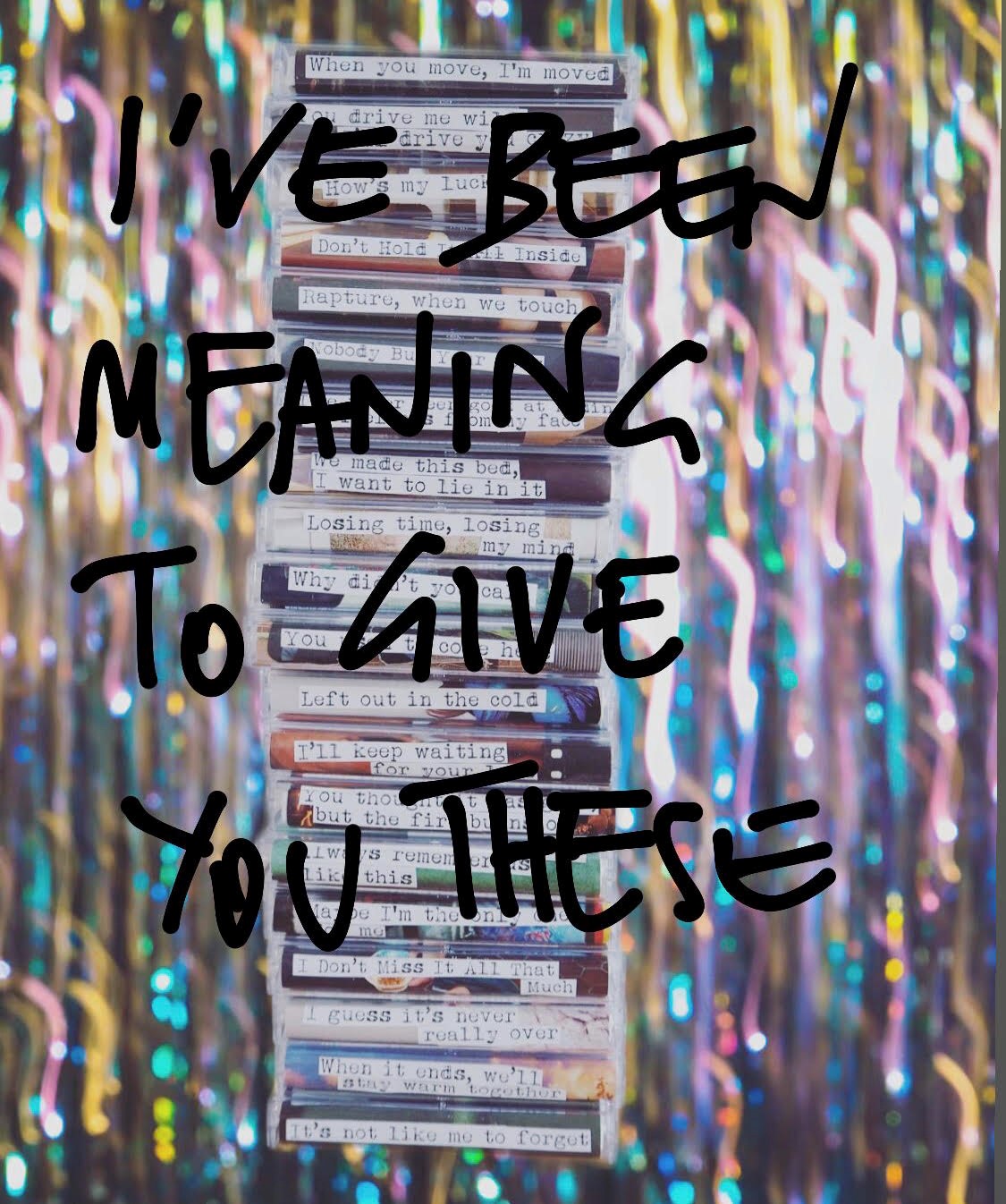
Beth Ferialdi I’ve Been Meaning To Give You These, 2020, dimensions variable, hand cut and digital collage, 1/1, printed by Fitzgerald Photo
Your work I’ve Been Meaning To Give You These is a nostalgic throwback to the mixtape and cassette players of the 80s and 90s. Why were you so drawn to exploring this theme? Did you have a cassette player when you were growing up?
In the past 2 years, I have found the pieces I enjoy making the most include an element of text and, similar to my previous FAC Print Award piece, I like to rearrange themed text to create new poetry and prose. I have a great love for music and tend to fall in love with lyrics and play songs on repeat for days, so being able to tell a story through the arrangement of track lists and lyrical cassette titles was very appealing. Growing up there were 4 kids in my household and my two brothers being the oldest, both received Walkman portable cassette players one year for Christmas. I would borrow these any chance I was given and then finally inherited one, once they had graduated to a Discman. The creating of mixtapes for me started when I would sit by my cassette player on a Sunday evening and record songs on a tape from the American Top 40 radio show. In high school I would burn tracks downloaded from Limewire to CDs curated for my friends. The idea for the piece originally started from a series of themed playlists I was compiling on Spotify. I wanted to create something more of a tangible collection and given my love of collage, was drawn to the era of magazine cut-outs and the original mixtape, CDs didn’t feel right for the piece.
The work takes on a highly personal note with the inclusion of some of your friends singing the tracks. Why did you decide to take this route?
Even without the inclusion of my friends singing on these tapes, the piece would have felt very personal to me. I am drawn to music because, unlike anything else, songs can appeal to millions of people but also feel incredibly personal and through these we can connect with others. I didn’t intend on creating this piece for a wide audience, it was amusing and something I enjoyed making, simply for the process. I thought about how I could make the piece a collectible that could sit on my shelf at home, which is why I wanted to do something special with what was recorded on the tapes. I recall a podcast episode where someone had spent a year recording his friends at social gatherings and even much more mundane times and the idea of this had always felt really beautiful and comforting to me. So for selfish reasons I wanted to capture my friends in this moment, to listen back in 5, 10, 20 years time to be reminded of them and perhaps laugh about it with them. Initially, I thought it would be near impossible to get enough friends interested in, or even regrettably agreeing to, singing for the project. I wanted the singing to be real and showcase the enjoyment and emotion it brings, so the instructions were to put your headphones on, press record and sing your heart out (and guess what.. there’s no backing track).
Let’s say hypothetically someone has just finished listening to the tapes in your work in the gallery. Ideally, how would you like them to respond or to feel?
Ideally, I would hope that people felt joy and amusement listening to an acapella version of a familiar song. I would hope they may even cringe or laugh, embodying some of the embarrassment that was felt by my friends before, during and after recording themselves. I would hope that they left the gallery with a smile on their face, being inspired by how each of these people had allowed themselves to be so vulnerable and courageous. And finally perhaps having a want to turn up the radio and see how it feels for themselves.
You will be co-presenting FAC’s first ever Karaoke Party at the Print Party on Wednesday 14 July. What can audiences expect on the night?
People can expect a night of celebration to mark the end of the Print Award with singing, dancing, artist talks and food and drink available. The karaoke set has been curated, by myself and the friend who first introduced me to collage, from songs that feature on the track lists across the twenty cassette tapes in my piece. Songs from the 60s, 70s, 80s, 90s and 00s will all feature, so there will be an opportunity for everyone to get on board, either taking the plunge with the microphone, singing along from the crowd or having a boogie in the courtyard. Bring mum and dad, bring the neighbour, bring the kids, there’s something for everyone!
Featuring Karaoke, artist talks, food, drinks and the chance to browse the exhibition before it closes on Sunday 18 July, the Print Party kicks off at 6pm on Wednesday 14 July. View more details and RSVP.
Amanda Bell’s From our lip, mouths, throats and belly – one of the standout works at the 2021 Revealed Exhibition – has been acquired by the Art Gallery of Western Australia, the City of Fremantle and Despina and Marcus Canning AM; a momentous achievement for the Bunbury-based emerging artist.
A Badimia and Yued woman, Bell’s striking neon sculpture features the Noongar word “Moorditj” (good or awesome) alongside audio stories from local Elders. The work explores the power of language in connecting with one’s cultural and familial heritage.
Fremantle Art Centre Director Anna Reece commented, “We are absolutely thrilled to announce this significant acquisition of Amanda Bell’s work, including her first work to be collected by the state gallery – a major career milestone.”
“Both a celebration and a tribute to Noongar language and culture, we are ecstatic to see this artwork gain the platform and accolades it so deserves.”
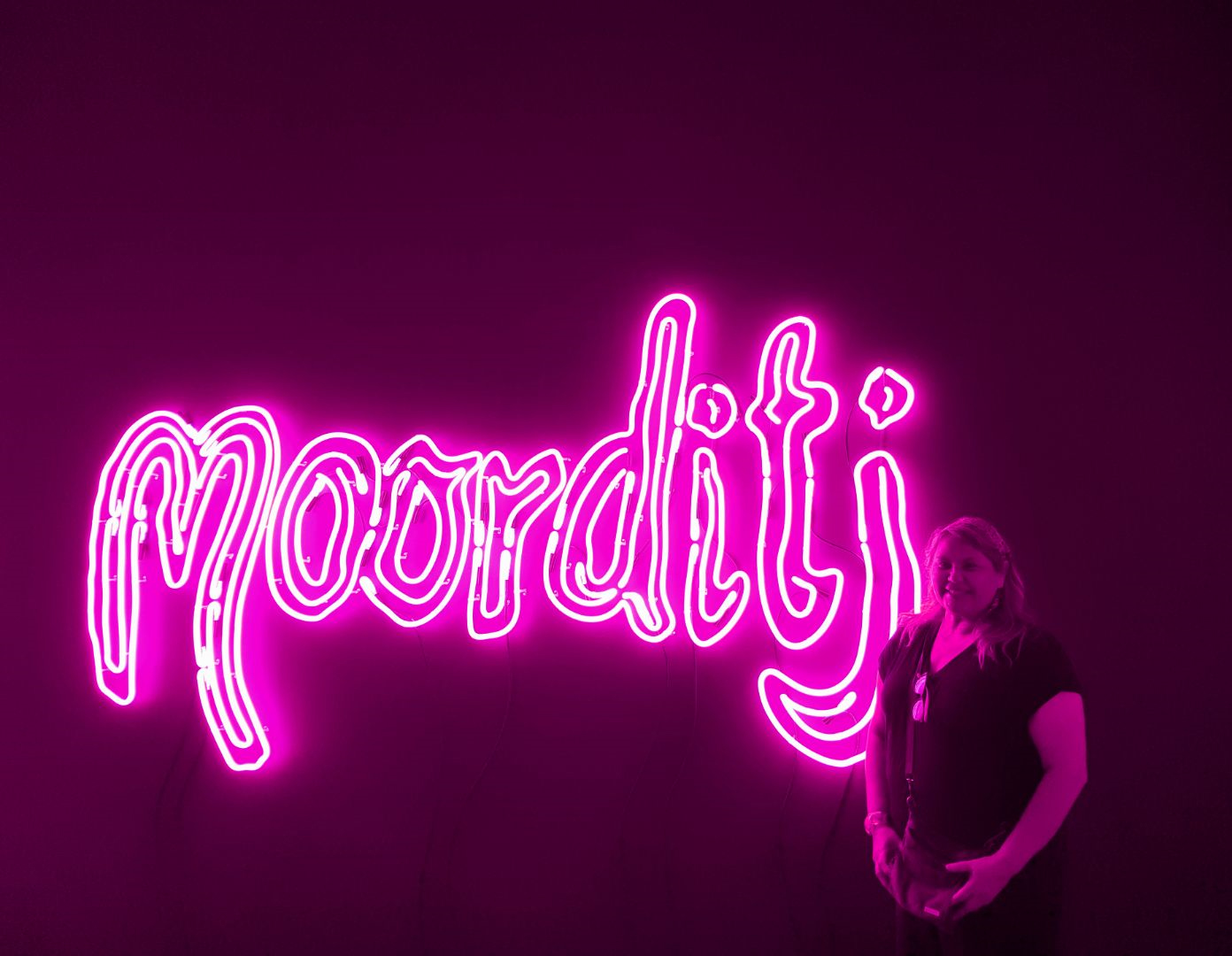
Amanda Bell pictured with her work From our lip, mouths, throats and belly at Fremantle Arts Centre, 2021 Revealed Exhibition
From our lip, mouths, throats and belly was premiered at Fremantle Arts Centre’s (FAC) 2021 Revealed Exhibition, an annual showcase of Western Australia’s emerging Aboriginal artists. The work was created with support from a Department of Local Government, Sport and Cultural Industries grant.
The Art Gallery of Western Australia acquired the work as part of the AGWA Foundation COVID-19 Stimulus package. The work will complement other neon sculptures in the State Art Collection by nationally acclaimed Indigenous artists, including Brook Andrew’s 1998 Ngajuu ngaay nginduugirr [I see you] and Reko Rennie’s 2020 OA Warrior I (blue) and OA Warrior II (pink).
From our lip, mouths, throats and belly will go on display in Balancing Act as part of the Art Gallery of Western Australia’s rooftop launch program later this year.
The Art Gallery of Western Australia’s Director Colin Walker commented, “We’re delighted to acquire Amanda Bell’s From our lip, mouths, throats and belly.”
“The work not only signifies the importance of language as identity, and in keeping history alive, it also explores the beauty of the Noongar language through a single word, Moorditj.”
The City of Fremantle has acquired an edition of the work to go on permanent display in Fremantle Arts Centre’s front garden, as a bold symbol of gratitude and respect to the Whadjuk people and all of Australia’s First Peoples.
The third edition is joining the collection of Despina and Marcus Canning AM and will be on display in August at Noongar Country 2021 | Power and Healing: Now, at the Bunbury Regional Art Gallery before installation at The Rechabite later in the year.
From our lip, mouths, throats and belly was inspired by Amanda Bell’s experience of her mother’s passing, during which time she started learning Welsh as a method of connecting to her past. It also touches on the enduring power of words as cultural artefacts over millennia, and the resilience of Aboriginal people in seeing their lives as “Moorditj” despite the presence of hardship.
According to Bell, “Words are ancient. They are a very powerful way to connect to and honour our past, and the work is a reflection of this.”
“Growing up, I never saw any of my language or my people represented in the physical environment of the cities I grew up in. I never looked up and saw myself reflected back.”
“To know that my artwork and the word Moorditj will be represented in such important institutions and seen by young Noongar people… it’s such an honour. It hasn’t sunk in yet, maybe it never will.”
About the artist
A Badimia and Yued woman, born on Whadjuk Country, Amanda Bell lives and works on Wadandi land by the sea. She has a diverse creative repertoire, working with sculptural materials, video, sound, textiles, found objects, and most recently neon lighting. Her works are ambitious and experimental, and with them she aims to “… try new ways of telling stories that are sometimes uncomfortable and painful, sometimes fun and frivolous.”
She has been featured in various exhibitions, including Fremantle Arts Centre’s Revealed Exhibition and Bunbury Regional Art Centre’s Noongar Country, and her work is held in various state and private collections.
Artwork description
Amanda Bell, From our lip, mouths, throats and belly, 2021, neon, audio, 158 x 300 x 6cm. Photography by Pixel Poetry.
Media contact: Rosamund Brennan, [email protected], 08 9432 9565
Internationally renowned artist Jacobus Capone will debut Beating Heart – the largest exhibition of his works to date – at Fremantle Arts Centre on 23 July.
Incorporating performance, video, installation and works on paper, Beating Heart is a cinematic exploration of human and ecological fragility in an age of increasing anxiety, denial and isolation.
Erin Coates, FAC’s Exhibitions and Special Projects Curator, commented, “One of Western Australia’s most exciting contemporary artists, Capone’s practice has steadily gained momentum over the last decade, with a number of international exhibitions and residencies to his name.”
“We are thrilled to present his largest exhibition to date here at FAC, which ponders the big questions of one’s mortality and spirituality in the face of nature’s decline, imbued by a sense of awe and dark optimism that is typical of Capone’s work.”
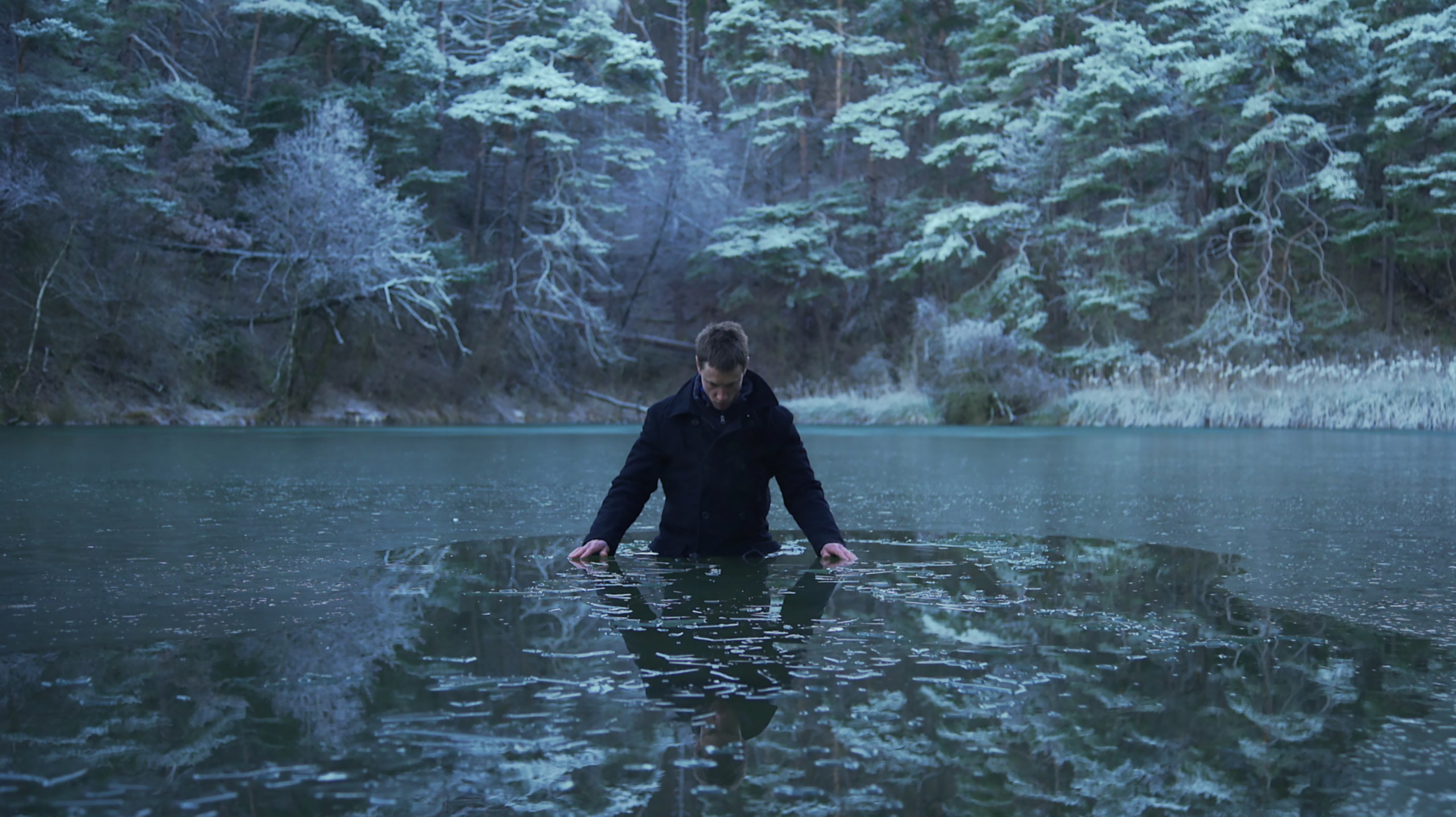
Echo & Abyss – Chapter 4, Scene 3 (video still), 2018, synchronised 10 Channel HD video, dimensions variable. Composition by Alex Turley. Images courtesy the artist and Moore Contemporary
At the centre of the exhibition is Echo & Abyss (2018), an epic 10-channel video installation, shown in its entirety for the first time. A homage to Rainer Maria Rilke’s Duino Elegies – a monologue of the poet coming to terms with human existence – Echo & Abyss plunges audiences into sublime, frozen landscapes, including the Greenlandic ice sheet and Sierre in Switzerland, where the poet was laid to rest.
From journeying to the depths of a cave to devotionally documenting the death of leaves from trees surrounding Rilke’s home, this unfolding pilgrimage sees Capone voyage to remote and fragile landscapes, capturing intimate moments between man and nature that symbolise both our desire for unity and our complicity in its demise.
According to Capone, “Blending poetic fiction and reality, the project embraces a sense of hopelessness in order to more readily accept inevitable extinction.”
“The desire to reconcile one’s relationship with the world around them is juxtaposed with that “world” being put at risk by humankind itself.”
Also showing as part of Beating Heart is Perdition & Prayer (2020-ongoing), a delicate series of works on paper, featuring copper leaf, volcanic ash and glacial water on Japanese Mingeshi paper.
The shapes and markings rendered on each work are drawn from Capone’s back catalogue of performative work, in effect building a personal iconography that seeks to honour the artist’s influences, while reflecting humanity’s desire to seek meaning within an increasingly turbulent environment.
Thanatousia features 34 handmade flags, one for every year of the artist’s life. A ritualised, lifelong project, the flags alternate through three phrases: “You will die. I will die. We will die”. A collaboration between Capone and his mother, Maria Gomes, who was a flag maker, Thanatousia seeks to psychologically confront one’s mortality by surrendering to it.
Capone said of the exhibition, “It’s an honour to be able to exhibit these 3 intertwined projects across the whole south wing of the Fremantle Arts Centre. A space that I’ve long admired for its ambitious programming and variety of content offered to the wider public.”
“Over the past year it’s been a privilege to have a studio in the building to develop two major and ongoing projects that will feature. Both being major turning points in my practice.”
Beating Heat runs from 24 July – 7 September, 10am – 5pm. Free entry, all welcome
About the artist
Jacobus Capone, born in Perth in 1986, is one of Western Australia’s most compelling artists to have emerged over recent years. He received his Bachelor of Visual Arts from Edith Cowan University in 2007, graduating with a work that saw him cross Australia by foot, to pour water from the Indian Ocean into the Pacific (which he carried each day on the 147-day journey).
Recent major solo exhibitions include: 7 Cuts to the Landscape, Station Sydney (2020); Piteraq, Moore Contemporary, Perth (2020); Dark Learning, UQ Museum Queensland (2019); Sincerity & Symbiosis, Perth Centre for Photography (2019); and Forgiving Night for Day, Perth Institute of Contemporary Art (2017).
For interviews, imagery or more information please contact Communications Officer Rosamund Brennan on [email protected] or (08) 9432 9565
Image at top of page: Jacobus Capone, Echo & Abyss – Chapter 6, Scene 9 (video still), 2018, synchronised 10 Channel HD video, dimensions variable
Fremantle Arts Centre presents The Archaeology of Loss, the first Western Australian exhibition of acclaimed Ukrainian-Australian artist Stanislava Pinchuk.
Stemming from her experiences of the illegal invasion of Ukraine by Russia, Pinchuk’s practice investigates how landscape holds remnants of political and environmental upheaval and trauma, reflecting the patina of human experience, accrued over time.
Performing the role of both archaeologist and cartographer, she collects topographical data from sites of conflict and disaster, including Fukushima, Chernobyl and the Calais Jungle migrant camp. With a multidisciplinary practice that spans drawing, installation, tattooing, film and sculpture, Pinchuk translates geographical elements into delicate artworks that speak to the enduring cost of war and conflict, both material and immaterial.
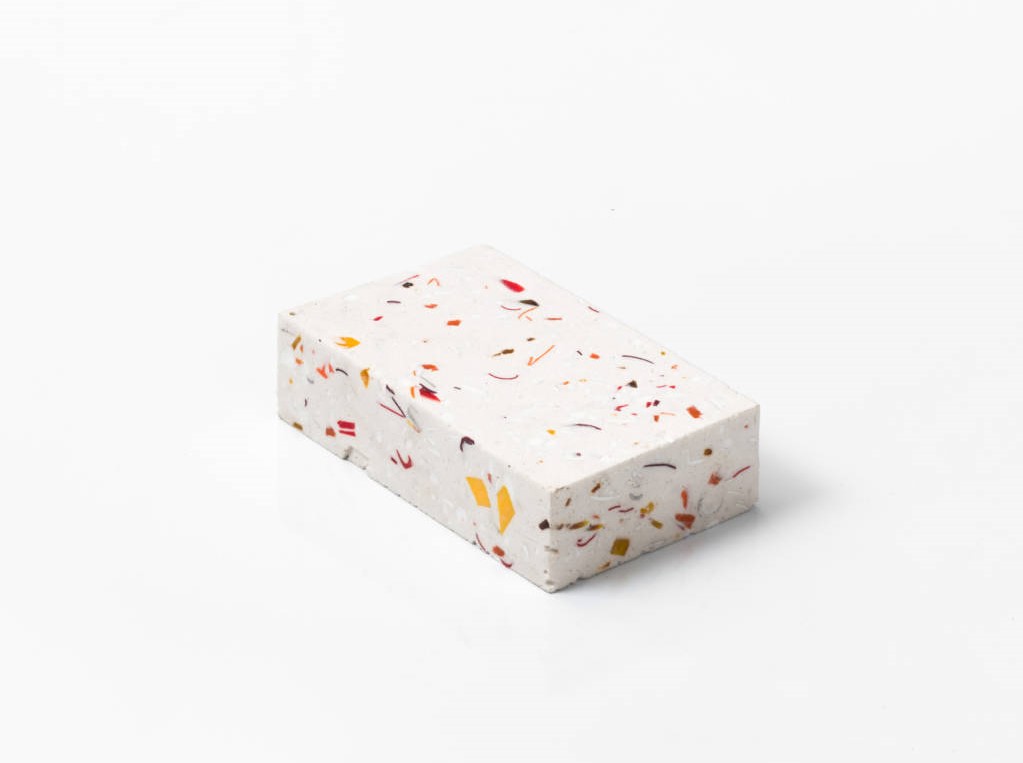
Calais ‘Jungle’ Terrazzo V, camp remnants, ash resin, 18.5 x 11 x 5 cm.
Curated by Rachel Cieśla, The Archaeology of Loss brings together Pinchuk’s sensitively rendered pin-hole topographical drawings, terrazzo sculptures and incidental photography, charting her habitation and movement across the Ukraine, France and Japan.
According to Rachel Cieśla, “As the title of this show suggests, the work of Stanislava Pinchuk appears as an archaeology of loss. It is a study beginning with the ongoing crisis in Pinchuk’s home country of Ukraine, and which travels with her, as she evocatively traces the relationship between meaning and non-meaning within landscapes drastically altered, and permanently marked by conflict and catastrophe.”
Among the exhibited works is the series Borders (2018), including nine terrazzo sculptures which preserve the survival objects trampled into the ground during the traumatic dismantlement of the Calais Jungle migrant camp.
Made after travelling to the Chernobyl Nuclear Exclusion Zone, Sarcophagus (2017) is a tapestry that maps the radioactivity levels of raw earth at the Sarcophagus built over Reactor 4 and in concrete laid before and after 1986. The data woven into the tapestry presents a broad range of influences; part funerary shroud, part bridal veil, moving us to consider how the fallout of distant events can come to rest on our skin and touch our lives in the most intimate of ways.
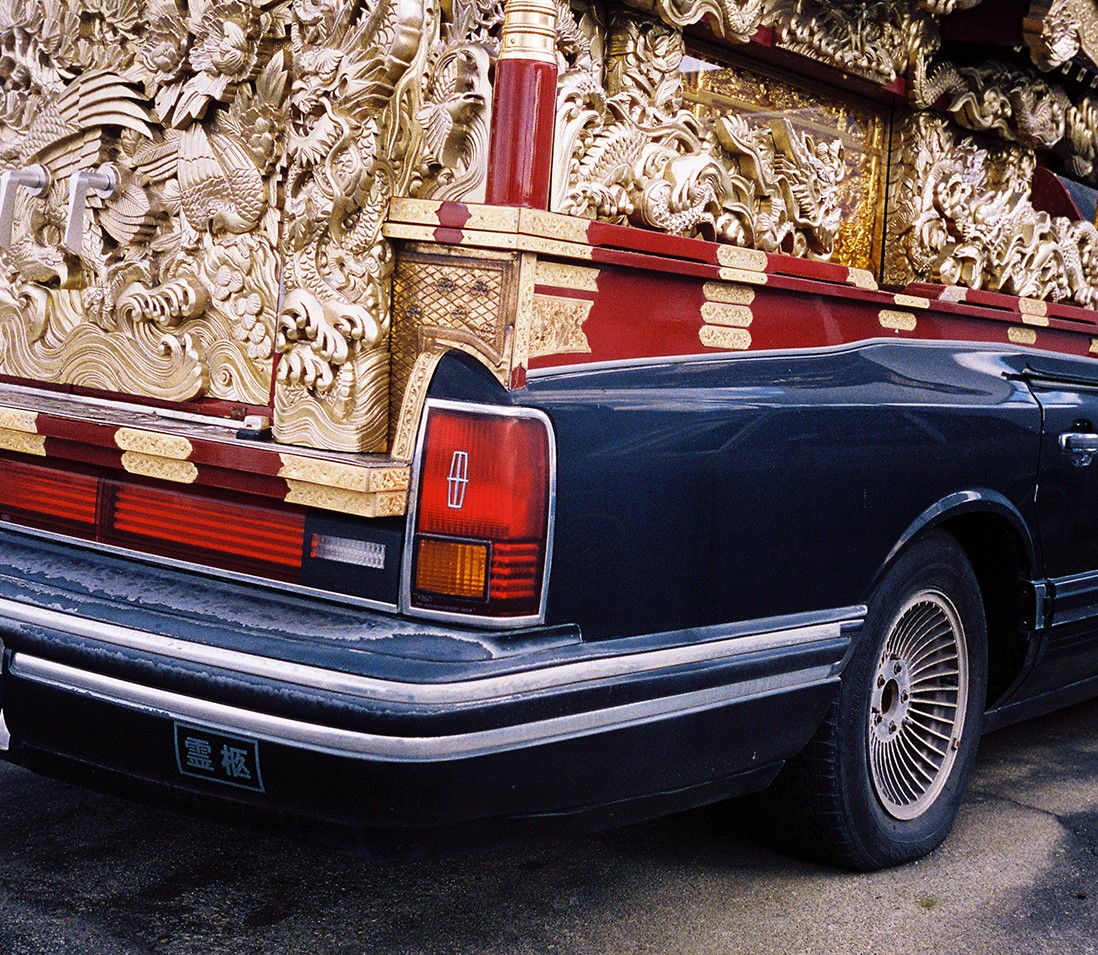
Fukushima X Abandoned Funeral Hearse (detail), 2016, giclee print photograph on cotton rag, 75 x 101cm, edition of 3. Images courtesy the artist and Yavuz Gallery
Surface To Air (2015) is a mapping of the Ukrainian crisis across landscape topographies and sonic scores. While a nod to the S.T.A missiles used in the conflict, the title also hints at the experience of war from a private perspective, coming up for air in resilience.
Surface topographies are mapped within the folds of large textile sheets, plotting the contour of the land, changing borders and conflict zones as they fall. These works show the feeling of standing on fragile ground, how easily it can be pulled out from underneath.
FAC Exhibitions & Special Projects Curator Erin Coates said, “After an acclaimed career survey at the Heide Museum of Modern art, we are thrilled to be unveiling the artist’s first show in Western Australia.”
“At once hopeful and despairing, her works articulate notions of cultural displacement, of silenced populations, of the decimation of land and of peoples. And ultimately, of the way land is both a testament and a mirror to human experience.”
The Archaeology of Loss runs from 24 July – 7 September, 10am – 5pm. Free entry, all welcome
About the artist
Stanislava Pinchuk (b. 1988, Ukrainian SSR) is an artist exploring the changing topographies of war and conflict zones.
Recent solo exhibitions include Terra Data (Heidi Museum of Modern Art, 2021), The Wine Dark Sea (Yavuz gallery, Sydney), The Red Carpet (Sydney Opera House, 2020), Immigration Granulation (Immigration Museum, Melbourne, 2019), as well as beginning production on her debut film commissioned by Australian Centre for the Moving Image (ACMI), Melbourne for a solo exhibition in 2022. Her work has been previously been supported by major institutions such as The New Museum, New York and the New Inc. / Columbia University GSAPP Architecture Incubator; the Victoria & Albert Museum; and the Wellcome Museum, London, UK.
Pinchuk’s artwork and publishing archives are held in numerous Australian and international private and public collections including Le Louvre’s Musée des Arts Decoratifs, Paris; National Gallery of Australia, Canberra; Museum of Contemporary Art, Sydney; National Gallery of Victoria, Melbourne; ACMI, Melbourne; La Bibliotheque Nationale de France; University of Queensland Museum; The State Library of Victoria, Melbourne; Art Gallery South Australia, Adelaide; Heide Museum of Modern Art, Melbourne; and the Art Gallery Western Australia, Perth.
Pinchuk graduated University of Melbourne in 2011 with a Bachelor of Arts and double major in Art History and Philosophy.
For interviews, imagery or more information please contact Communications Officer Rosamund Brennan on [email protected] or (08) 9432 9565
Image at top of page: Stanislava Pinchuk, Chernobyl Reactor 4, I (Data Map: Topographic Radioactivity) (detail), 2017, pin-holes on paper, 75 x 101cm.
Ahead of her upcoming Artist Talk and Catalogue Launch, Deanna Hitti spoke with FAC about her exhibition Object of the Game, and the heart-rending experiences of grief, loss and cross-cultural connection that inspired it
An Australian artist based in Melbourne with Lebanese heritage, Deanna Hitti’s practice often explores the diverse cultural traditions that co-exist in Australia, as well as migrant identities and the nuanced representations of the East and West.
She won the prestigious Fremantle Arts Centre Print Award in 2018 with her artist book Towla, which explores the cultural significance of backgammon in Lebanon, setting out the rules of the game in the Arabic and Latin alphabets. Her latest exhibition Object of the Game, showing at FAC till 18 July, brings this exquisite work back to Western Australian audiences, alongside a new series of work including an instructional audio-visual projection, interactive backgammon display and large-scale cyanotype screen-print titled Object of the Game.
Your book Towla features the instructions for backgammon (Towla) in both the Arabic and Latin alphabet. Why are you so interested in exploring the ancient tradition of Towla and what does it mean to you?
The work is about growing up in Australia and the third culture that often emerges amongst migrant communities. My parents were born in Lebanon, so growing up I had to contend with their traditions and ideas at home, as well as those of the local culture I was learning at school and from socialising. Although I have to say it wasn’t much of a social life as I wasn’t allowed to go out much! The home life was very central, and it was very traditionally Lebanese. My father and I were both very headstrong, and Towla was a way of bridging the gap between us, of solving our cultural differences. Instead of talking through an issue, he would simply say, ‘let’s play’. Even if it was just half an hour, nothing else really mattered during that time.
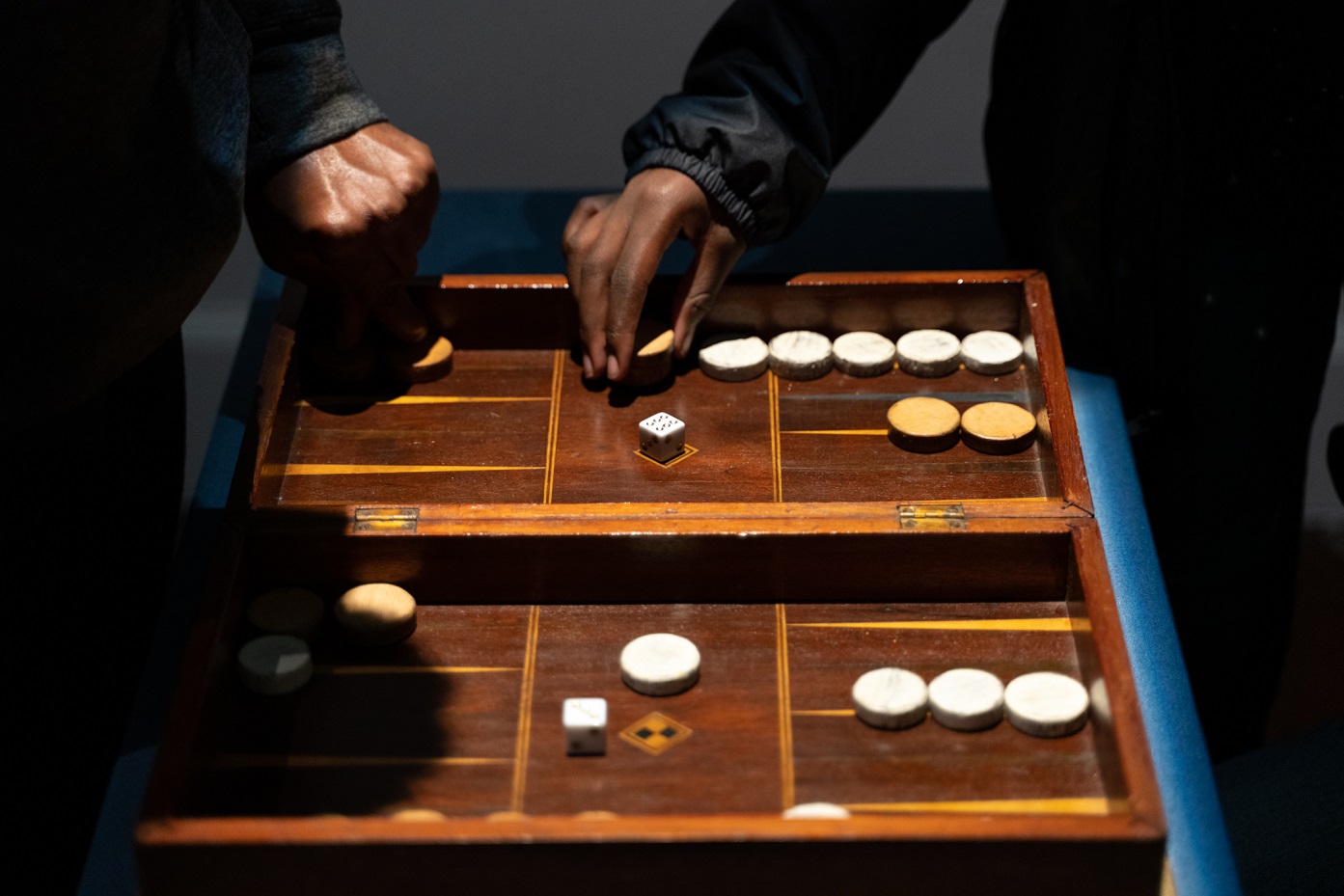
Deanna Hitti: Object of the Game, installation view. Photography by Pixel Poetry.
Your late father Antonios El Hitti helped you to co-create the translations. What was the thinking behind collaborating with him on this project?
My dad and I, we would text all the time. And when we spoke, there was always some kind of cultural transaction happening, as he might speak to me in broken English and I would respond in broken Arabic or vice versa. It was always a play with language. So, I thought we could flesh this out a little bit with the rules of backgammon and turn it into a book, with the English and Arabic letters sitting together side by side.
I understand that Antonios suddenly passed away in the midst of this project. How did you go about completing Towla in his absence, and how did his passing impact the work?
Yes, my father was in Lebanon and we received an unexpected phone call from a relative to say that he had passed. It was quite a traumatic time for my family, we were all just trying to hold it together. I was grieving and I found it difficult to focus on normal day to day activities. Towla was one thing I seemed to have energy for. It was a way of dealing with the sudden loss and contending with all the thoughts and feelings that were running rampant in my head. It ended up being a way to hold his memory. The translations for Towla were about three quarters done and I asked my Syrian friend Katarina Acher to assist me in completing the translations. Finishing the book after my father passed away was quite contemplative and, in a way, a healing experience. That’s the great thing about artist books for me. I can create a contemplative space for myself and the audience to talk about many personal and social themes. It all comes back to time.
In 2018, you won the Fremantle Arts Centre Print Award with your artist book Towla. How did it feel? Did it come as a surprise?
I got a phone call from Emma Buswell (FAC Print Award Coordinator) which I missed. I assumed there was something wrong with the work, or that it didn’t arrive or something. And then I called back and she just said, “I’ve got some news for you, you’ve won”, and it was magic. It felt as though the art world was mine just for that moment. To be recognised by your peers in such a highly regarded Award, it was just an ecstatic feeling.
And how does it feel to be back here to present Towla alongside a new series of works for Object of the Game?
It’s wonderful to be back. I worked with Andre Lipscombe (Curator, City of Fremantle Art Collection) to develop the exhibition, alongside artist Steven Alyian who was instrumental in developing the multimedia and sound. They were both fantastic to work with, very thorough and understood my vision while offering their own expertise. Fremantle has such a great sense of community and the Arts Centre is well respected, so it really is a joy to exhibit here.
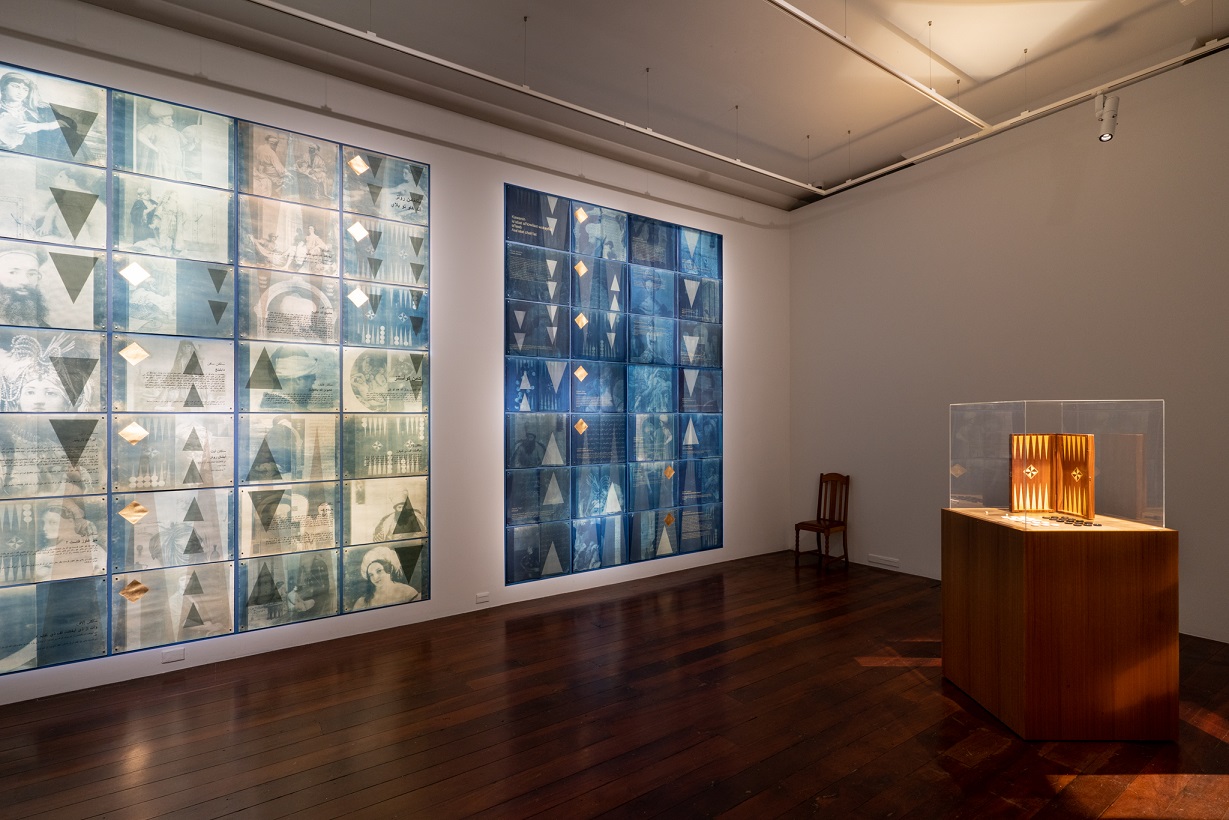
Deanna Hitti: Object of the Game, installation view. Photography by Pixel Poetry.
The exhibition also features a new work titled Object of the Game, which features an image of La Grand Odalisque, the famous oil painting of a young girl from the Middle Ages. Can you explain what this is in reference to?
This work appropriates imagery from the European Masters to question preconceived notions of Middle Eastern identity. In the west, most of our understandings of Middle Eastern people come from 18th century writers and painters, most of whom never actually went to the region. I scanned books and took fragments of images, reproducing them in cyanotype and then printing again on top of it with Arabic lettering and some Towla symbols. The world we live in today is so politically loud, I like to make art which is quiet and contemplative. With paintings people often quickly make a judgement call, but I hope that Towla and Object of the Game encourage people to sit with it a little longer and let the message wash over them.
Keen to hear more? Come along to the Artist Talk and Catalogue Launch on Saturday 19 June from 2- 4pm. After a relaxed floor talk, Deanna will unveil the Object of the Game catalogue, a 40-page, limited edition publication produced in Arabic and English. Deanna Hitti: Object of the Game is showing at FAC till Sunday 18 July.
First Prize
ALISON KENNEDY (VIC)
ICU, 2019
Melbourne-based artist Alison Kennedy has taken the coveted first prize in this year’s Fremantle Arts Centre Print Award with her work ICU. A large-scale self-portrait made using white ink screen-printed on 30 industrial polyacrylic panels, ICU explores women’s work and the hidden labour of underrepresented groups. She wins $16,000 in prize money and the print will be acquired by the City of Fremantle Art Collection.
This year’s judging panel – Felicity Johnston, Rachel Salmon-Lomas and Lia Mcknight – commented, “Alison Kennedy’s skilfully composed work ICU is a brave and poignant portrait of the artist in her studio, her face and body partially obscured by glitches that reveal the artist’s use of digital technology.”
“Kennedy combines laboriously hand printed silkscreen with 3D modelling techniques, exploiting the effects of pixelation to create a seductive granular quality. Printed onto industrial acrylic sheeting, the work is one of many in the exhibition that is multi-panelled. In this case the glossy, reflective surface provides a sensual quality to the work that mirrors the viewer, placing us within this oversized portrait.”
About the Artist
Alison is a Melbourne (Naarm) based artist who combines technology, malfunction and handmade media. Her practice is grounded in a desire to reveal what is hidden through closely observing the artistic process as it twists and turns. Underneath it all she asks, “When does something make sense?” This often leads to artwork that surprises herself as well as others.
Her work and research have been critically received. Kennedy was included in the 10 year survey show of Leipzig International Art Residency (Germany) and in the 2021 ANAT DNA research residency program. She has exhibited widely in Australia and Germany. She recently graduated with a Master of Fine Arts (Research) from Melbourne University, where she won the Fiona Myer Award in 2019.
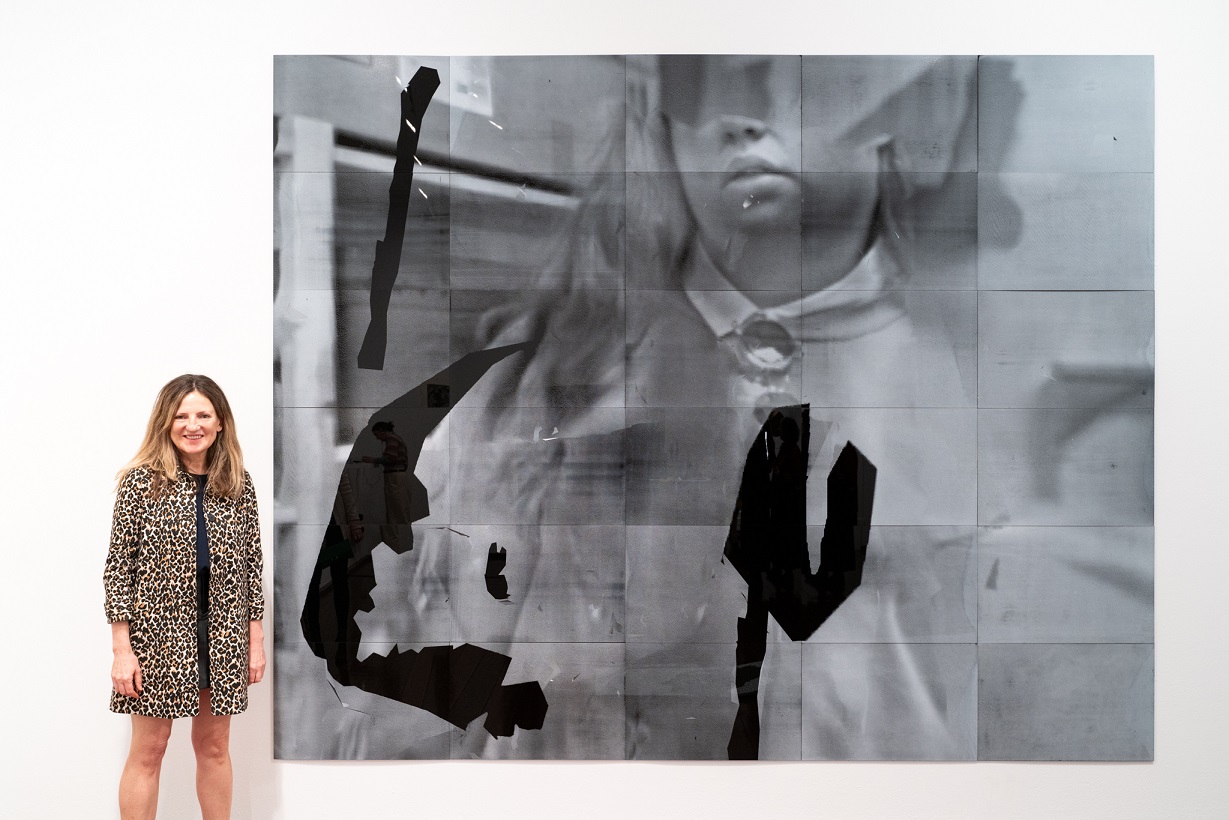
Alison Kennedy with her winning work ICU, 2019 at the FAC Print Award Exhibition opening. Photography by Pixel Poetry.
About the Work
ICU (2019) valorises the female artist in her studio and is part of the artists’ overarching concern with expressing women’s work through meshing technology with printmaking. The artist says of the work: “The latter is crucial as it is through this refined laborious process that woman’s work is expressed as both method and subject. It is important in my practice that technology acknowledges and represents the role of the human body in perceiving and creating the world.”
In creating this work, Kennedy has transformed an image of herself at work in the studio, through scanning into a 3D model. Her image, altered by a technology pushed to the breaking point, becomes amplified, refined and clarified through the process of print making. The materiality of the work showcases the orthogonal individual white specks, almost like the detail found when zooming in on a bitmap. The large scale valorises hidden labour of the underrepresented – the technological obfuscations both blind and reveal. ICU invites you to consider, who exactly sees who?
Second Prize
JOHN PRINCE SIDDON (WA)
Purlkartu (Spider), 2020
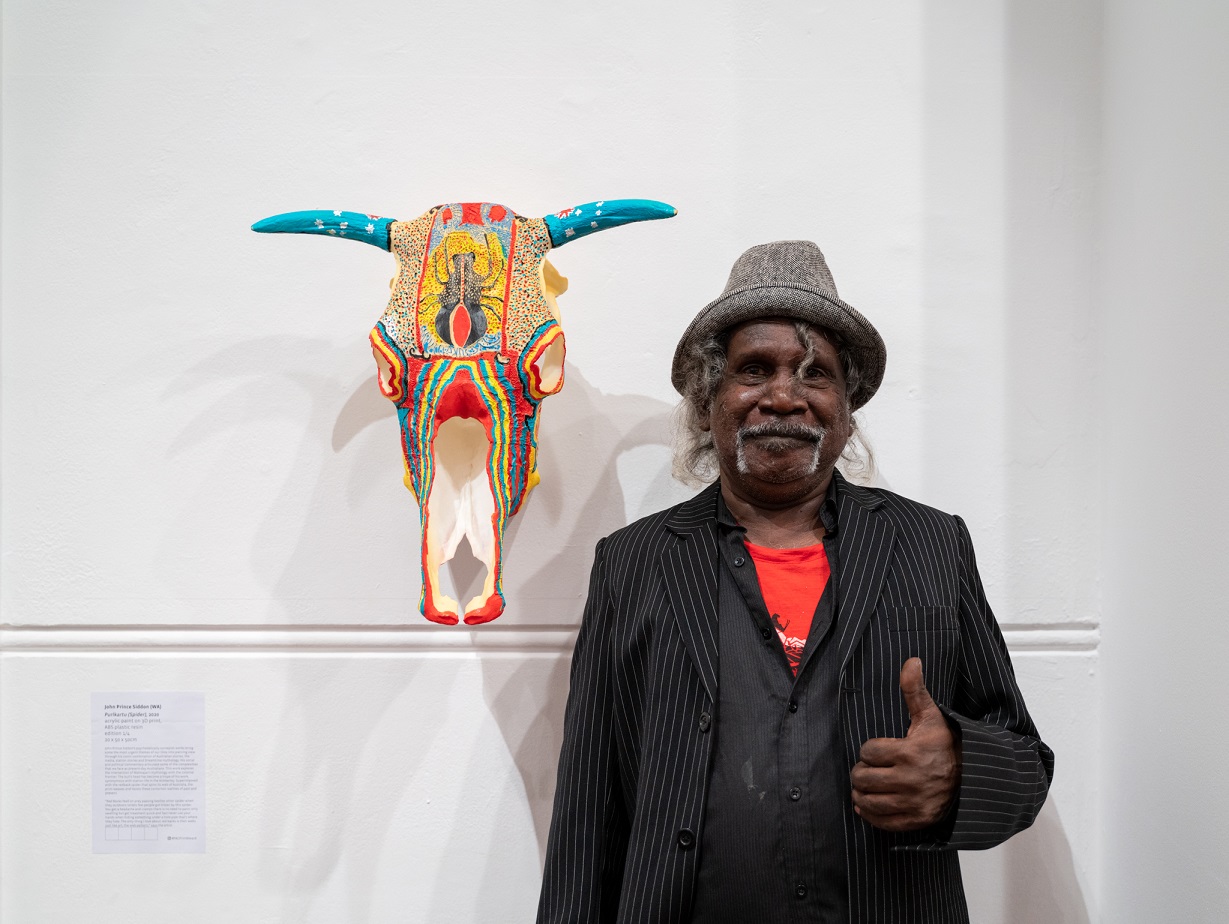
John Prince Siddon at the 45th FAC Print Award Exhibition opening, next to his work Purlkartu (Spider), 2020.
Walmajarri artist John Prince Siddon has been awarded the second prize for his work Purlkartu (Spider), a 3D printed cow skull imprinted in his bold, distinctive painting style, referencing his Country and culture. He receives a $6,000 cash prize. The judging panel said of his work, “Purlkartu (Spider) is arguably the most vibrant work in the exhibition.
Having painted cow skulls for many years now, Siddon has hand painted a 3D printed skull, the surface of which features a lace or skin-like texture, derived from one of his 2D paintings.”
“Dynamic and raw, it reflects the bold landscape and intensity of light characteristic to Siddon’s home Country in the Kimberley. This work is very much in keeping with Siddon’s distinctive and eclectic style, a magnetic combination of imagery and colour that references Country, culture and the bloody histories of colonisation.”
About the Artist
John Prince Siddon is a Walmajarri man born in Derby in 1964. Currently based in Fitzroy Crossing, he is the son of Pompey Siddon, one of the founding painters at Mangkaja Arts Resource Agency.
Moving between 2D and 3D surfaces he renders confronting imagery inspired by national and global issues he sees on television, his own story, desert iconography and the Narrangkarni (Dreamtime). Prince has been a regular finalist in the prestigious Telstra National Aboriginal And Torres Strait Islander Art Awards since 2018 and was highly commended in the 2018 King & Wood Mallesons Contemporary First Nations Art Award.
In February 2020, Perth Festival commissioned John Prince Siddon’s first major solo show All Mixed Up, presented by Fremantle Arts Centre.
About the Work
John Prince Siddon Prince has been painting cow skulls in the Kimberley for many years and Purlkartu (Spider) is an extension of this practice into another media. The work was developed over a 12 month period in collaboration with Head 3D and Emilia Galatis Projects.
The process involved selecting a 2D art work to imprint, and employing this as a textural relief over the surface of the 3D print to create a lace or skin like texture. The work was printed after many months of refinement, then taken back to Fitzory Crossing to be painted. Purlkartu (Spider) is in line with Prince’s depictions of station stories and the horror of colonisation in the Kimberley, and is emblematic of the artist’s ability to straddle two worlds, challenging the accepted place of remote art making.
First Prize
Alison Kennedy
ICU, 2019
Second Prize
John Prince Siddon
Purlkartu (Spider), 2020
Highly Commended
Beth Ferialdi
I’ve Been Meaning To Give You These, 2020
Pip Lewi + Paul Sutherland
Road Repairs, 2020
Dan McCabe
Shadows on the hill,
2016 – ongoing
Cleo Wilkinson
Then IV, 2020
2021 Judging Panel
Felicity Johnston
Curator and Director, Art Collective WA
Rachel Salmon-Lomas
Printmaking lecturer and technician, Curtin University
Lia McKnight
Western Australian visual artist & Collection Manager, Curtin University
MEDIA CONTACT
Rosamund Brennan | 08 9432 9565
[email protected]
Image: Alison Kennedy, ICU, 2019, white ink screenprint on 30 industrial polyacrylic panels, 240 x 300cm, 1/1

